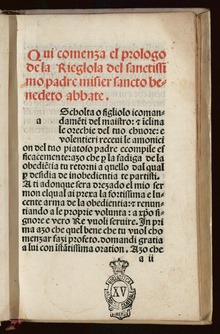Regula Benedicti


The Benedictine Rule or Benedictine Rule , also Benedictus Rule ( lat. Regula Benedicti [RB]), is a monastery regulation written by Benedict of Nursia , which he established for the community monastery of Monte Cassino in central Italy. Since its composition in the early Middle Ages (around 540) it has been the basis of the Order of the Benedictines (Ordo Sancti Benedicti (OSB)) .
History and content
The model was the so-called Magister rule (Regula Magistri), in addition to which influences of the Augustine rule can be recognized. The Rule of Benedict (RB) is intended as a guide for beginners in monastic life and recommends the Rule of St. Basil of Caesarea as a supplement for advanced learners . The RB consists of a prologue and 73 chapters.
- The prologue and chapters 1 to 3 cover the basics of monastic life .
- Chapters 4 through 7 deal with the monastic virtues, especially obedience , silence, and humility .
- Chapters 8 to 20 make arrangements for the opus Dei, the divine service which is of great importance in Benedictine life.
- Chapters 21 to 30 clarify penalties for violating the rule.
- Chapters 31 to 57 give instructions on the administration of the monastery, the services of the monks, the care of the monks, the reception of guests and the handling of handicrafts and craftsmen from outside.
- Chapters 58 to 66 regulate the admission of novices , the order of precedence in the community, the appointment of prior and abbot and the duties of the porter . According to Chapter 58, the religious vow includes the promise of stability ( stabilitas loci , i.e. attachment to a particular monastery), monastic life and obedience.
- Chapters 67 to 72 are considered supplements. They determine how the brothers interact with one another.
- Chapter 73 is an epilogue .
The RB was originally intended only as a handout for the residents of Benedict's own monastery on Monte Cassino.After the destruction of Monastery 577, it is no longer traceable for a few decades, but then appeared in Gaul , where in the Council of Autun (around 670 ) it was demanded that the RB should apply in the future. In particular, it was intended to replace the rule of the iro-Scottish monk Columban (the younger) , which was in force in Luxeuil and which was widely spread through the intensive iro-Scottish mission . So the RB spread in Europe, but was initially mixed with other rules, especially that of St. Columban, used.
It was only through the reforms of Benedict von Aniane that the RB, with the support of Louis the Pious, first became the sole authoritative rule of monks in the Franconian Empire and then throughout the West. Emperor Ludwig, son and successor of Charlemagne , made the corresponding resolutions of the Synod of Aachen (816-819) binding by making them binding as capitularies . In this way the standardization of the monastery system could be organized effectively.
As a supplement to the rule, so-called consuetudines (Latin for “habits”), texts that applied to individual monasteries or entire monastery associations, emerged over time. In spite of the uniform order, local peculiarities were also possible.
Besides the Benedictines and Benedictine also live Cistercians and Cistercian , Trappist and Trappist - both religious communities have emerged through reforms of the Benedictines - as well as the Camaldolese after the Benedictine Rule. The Book of Life of the Communities of Jerusalem is also based in part on their tradition.
The Bible reading prescribed in Chapter 48 of the RB can be seen as groundbreaking for the development of medieval monastery libraries . The obligation to read resulted in an implicit obligation on the part of the monasteries to provide books, i.e. for the monks to copy existing texts by hand and to maintain monastery libraries by the monasteries.
literature
Text editions and translations
- Sancti Benedicti Regula monasteriorum. Ed. critico-practicam adornavit Cuthbertus Butler. 3rd edition, Freiburg im Breisgau 1935.
- Basilius Steidle (Ed.): The Benedictine Rule: Latin-German. Beuron 1975; 4th edition ibid 1980, ISBN 3-87071-023-3 .
- Benedicti regula (= Corpus scriptorum ecclesiasticorum Latinorum. Vol. 75). Ed. by Rudolf Hanslik. Vienna 1960.
- The Rule of Benedict (Latin / German). Edited on behalf of the Salzburg Abbots' Conference. Beuron 1992.
- RB 1980. The Rule of St. Benedict, in Latin and English with notes. Ed. Timothy Fry. Collegeville, Minn. 1981.
- The Rule of Benedict, Latin / German, with the translation of the Salzburg Abbots' Conference. Edited by P. Ulrich Faust OSB, Stuttgart 2009.
- The Rule of St. Benedict. Edited on behalf of the Salzburg Abbots' Conference. 2nd edition, Beuron 2008.
Comments
- Terrence G. Kardong: Benedict's rule. A Translation and Commentary. Collegeville, Minn. 1996.
- Georg Holzherr: The Benedictine Rule. A guide to Christian living. 7th, revised edition. Freiburg / Switzerland 2007.
- Benno Linderbauer: S. Benedicti regula monachorum. Metten 1922.
- Michaela Puzicha / Johannes Gartner : Sources and texts on the Rule of Benedict. St. Ottilien 2007.
- Michaela Puzicha: Commentary on the Rule of Benedict. EOS Verlag 2002, second edition 2015, ISBN 978-3830677321 .
- Basilius Steidle: The Rule of St. Benedict. Introduced, translated and explained from ancient monasticism. Beuron 1952.
- Adalbert de Vogüé: The Regula Benedicti. Theological-spiritual commentary (= Regulae Benedicti studia. Supplementa 16), Hildesheim 1983 (French original title: La règle de Saint Benoît ).
Literature on individual questions
- Aquinata Böckmann: Perspectives of the Regula Benedicti. A commentary on the prologue and chapters 53, 58, 72, 73 (= Münsterschwarzacher studies. Vol. 37), Münsterschwarzach 1986.
- Edward Cuthbert Butler: Benedictine Monasticism. Studies on Benedictine Life and the Rule of St. Benedict. St. Ottilien 1929 (English original title: Benedictine monachism ).
- Teresa Karin Fischediek: The understanding of obedience of the “Regula Benedicti”. Obedience as the basis for an exemplary Christian community life (= Regulae Benedicti Studia. Supplementa, Vol. 13). St. Ottilien 1993.
- Bernd Jaspert: The Regula-Benedicti-Regula-Magistri-Controversy (= Regulae Benedicti Studia. Supplementa 3), Hildesheim 1975 (2nd edition 1977).
- Basilius Steidle: Contributions to ancient monasticism and the Rule of Benedict. With a foreword and an introduction ed. by Ursmar Engelmann, Sigmaringen 1986.
See also
Web links
- The Rule of St. Benedict in German (Melk Abbey)
- The Benedictine Rule in German with word concordance
- Detailed bibliography on the Rule of Benedict (developed by Aquinata Böckman)
- Rule of Benedict in the Niedermünster rule book from the holdings of the Bamberg State Library
- Brief introduction to the Rule of Benedict (English)
Individual evidence
- ^ Hubert Mordek : Canon Law and Reform in the Franconian Empire. The Collectio Vetus Gallica, the oldest systematic collection of canons in Franconian Gaul. Berlin 1975, p. 84 ff.
- ↑ Odette Pontal: The Synods in the Merovingian Empire. Paderborn u. a. 1986, p. 197 f.
- ↑ Monastic Communities of Jerusalem: In the Heart of the Cities. Book of Life of the Monastic Communities of Jerusalem . Herder, Freiburg i. Br. 2000, ISBN 3-451-27269-5 .
